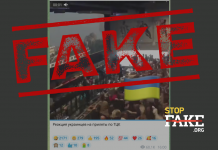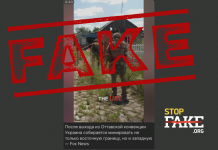Thinking about disinformation, we usually focus on operations aimed to misrepresent the reality or to give it own narrative. As Stop Fake we do purely journalist work here, we verify sources, check facts, determine real course of events and give the proven information. There are, however, outlets that focus their efforts on diagnosing the source of disinformation, the way it came through and determine what areas of state’s functioning does it touch. In the systemic way, Kamil Basaj from Info Ops Polska Foundation does such work:
„We should notice that the disinformation can be understood in different aspects, because we have disinformation as the whole system of influence on the way of seeing a particular event, but we should go deeper, looking for the origin of disinformation.”
A big role in understanding manipulation phenomena has elements related with so called reflected control – the art of shaping information not only through journalism but also other dimensions, such as inspiring or fabricating events to obtain through them influence on, for example, journalism:
“The aim is to focus the attention of the public on a particular event or on the way it is seen”, explains Kamil Basaj. “The essence of the reflected control is to plan a well addressed message according to needs of the audience – and it does not need to be false! If it is constantly transmitted in the underhand way – meaning that it is not possible to recognize it at first glance as false or manipulated – it has the biggest potential of influencing people because it feeds their memory. Therefore, disinformation in the operative meaning requires identifying not only false information but also the information which refers to, e.g., actual events but is transmitted in proper sequences, proper time or using, for example, state apparatus, informational opponent. This system of influencing we call “models of influence operations”.”
In the case of Russian Federation, the experts from Info Ops Polska Foundation currently identify 29 different models of feeding the informational environment with the information Russia demands:
“One of those models we showed in the report about the attempts of interfering with Polish-Ukrainian relations, where it is so called the model of spread influence, which in reality has relatively strong influence on the selection of information sources on the level of, for example, search engines”, says Basaj. “We showed there the path of information – it means the moment when a piece of information is published in media with obvious Russian affiliation and when there is no doubts about this affiliation. Such medium is, for example, Sputnik. Then, the content is converted to so called alternative informational portals, which often advertise themselves as alternative sources of knowledge or information or real information etc. Then, the content is made a hybrid by reformulating the thesis from, e.g., Sputnik’s article to the anonymous blogger’s post. The only thing connecting Sputnik article and the anonymous post is the cognitive effect the piece of information has.”
It turns out that not always it is the content that means, it is enough if it fulfills certain objective:
“In the case of recognizing this model, we do not use the message at all but mostly determine the effect it generates”, admits Basaj. “If we can, then, as a result of monitoring the web, identify the appearing of certain sequence of messages with the same cognitive effect, we assume this is coordinated and purposeful action. Then we monitor how this piece of information I distributed by social media, blogs or how is it addressed to certain groups of audience, for example to groups of pro-defense organizations. Those por-defense groups attract very special audience, interested in specific topics, therefore we find there more often opinions that undermine official stances on the international events. There are many such narratives – historical questions, economics, but here we are talking already about dedicated operations, therefore such that are aimed to manipulate precisely chosen group of audience but also precisely determined informational environment. What is required to identify this process is the research on potential predictable cognitive effects of given message – that means the influence it will have on the way of seeing the world now and in the future.”
Sputnik is a state information agency which has a network of radio stations and multilingual website. We presented its influence model above, but is it the only Russian propaganda outlet on our market?
“Sputnik is not the only actor that participates in manipulation processes”, says Kamil Basaj. “Although it is the only one which can be absolutely (besides technical analysis) classified as Russian propaganda center. In the model we talked about, it plays the role of the initiator, it implements the message into Polish-speaking informational environment. More than once it is a hostile message, aimed directly against Polish national security, for example because of the issues of manipulating the view on our allies, troops engaged in reinforcing the Eastern flank, including American army, promoting negative message about all alliances we make, not only in the defense area but also in the energy area – in order to lower the positive opinion about these relations in particular. Because what other can be showing American troops as defenseless, lost in Poland, constantly having traffic accidents? It is meant to create in long-term process of influence the satirical image of American soldier, his distorted image, as unable to help Poland in the case of actual threat of kinetical operations, of war in physical dimension.
WP





